Are you looking to enhance your skills and increase your value in the modern workplace? One important area of expertise that can set you apart is cross functional knowledge. In today’s fast-paced and complex work environment, the ability to understand and collaborate with professionals from different departments or disciplines is highly sought after.
Having cross functional knowledge means that you have a comprehensive understanding of various areas within your organization, beyond just your own specialization. This allows you to see the bigger picture, identify opportunities for synergy, and contribute effectively to multidisciplinary projects.
By developing cross functional collaboration, you become a valuable asset who can bridge gaps between different teams, facilitate communication, and drive innovation. So whether you’re an aspiring leader or simply want to expand your horizons, investing in cross organizational collaboration can greatly boost your career prospects.
What is Cross-Functional Collaboration?
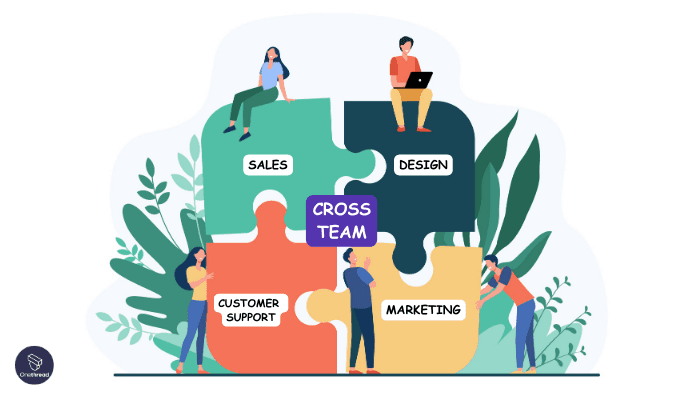
Cross-functional collaboration refers to the collective effort of individuals from diverse professional backgrounds and functional areas, working together in a team to achieve shared goals and complete projects.
Assembling individuals with varied skills and expertise from different departments, organizations can leverage their diverse perspectives to accelerate the execution of complex projects.
Benefits of Cross-Functional Collaboration in Teams
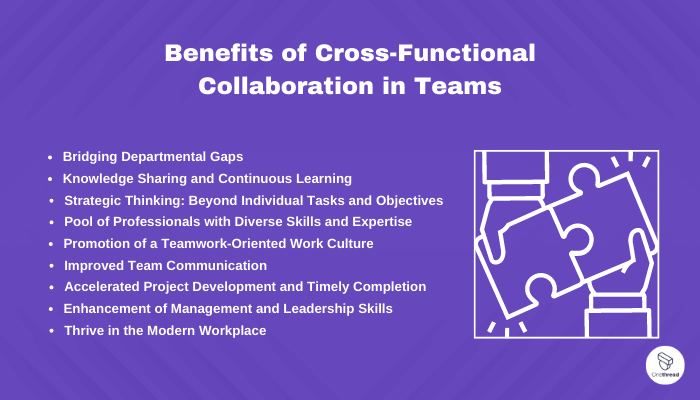
Implementing successful cross organizational collaboration within an organization may present challenges, but the benefits it brings make the effort worthwhile. This section highlights the key advantages that organizations can enjoy by fostering cross-functional collaboration among their teams.
Bridging Departmental Gaps: Facilitating Communication and Coordination
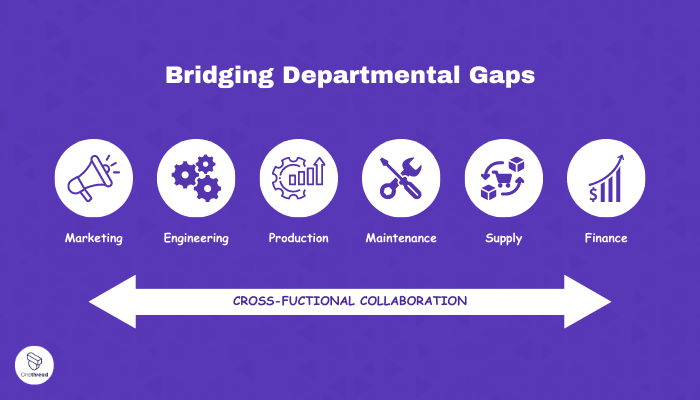
Understanding how different departments operate and collaborate enables individuals to break down silos within an organization. By acting as connectors, employees with cross functional knowledge bring together people from various functions to work collectively towards common goals.
This ability to bridge gaps not only enhances teamwork but also fosters improved communication and coordination, ultimately leading to increased efficiency and productivity. In today’s dynamic workplace, where collaboration is a key driver of success, this skill is highly sought after.
Knowledge Sharing and Continuous Learning
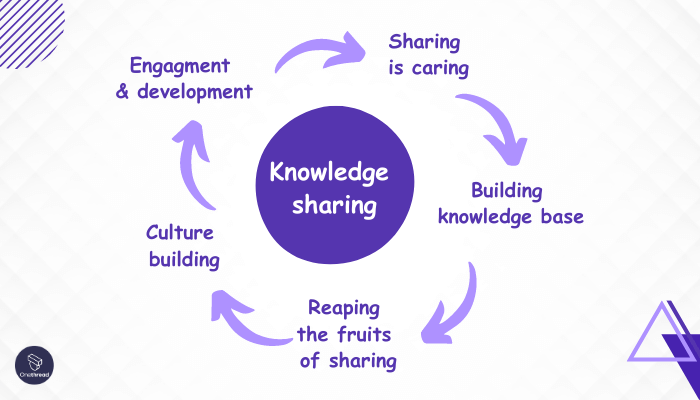
Cross-functional collaboration creates an environment where employees can learn from one another, enhancing their skill sets and improving the quality and quantity of their work. Collaboration between individuals with different expertise allows for the sharing of knowledge, fostering a culture of continuous learning.
This collective knowledge empowers cross-functional teams to navigate difficult situations effectively.
Strategic Thinking: Beyond Individual Tasks and Objectives
Cross functional knowledge empowers individuals to think strategically. By gaining insights into multiple facets of the business, employees develop a holistic perspective that extends beyond their own roles or departments.
This broader understanding enables them to make informed decisions that consider the bigger picture, rather than solely focusing on individual tasks or objectives. Consequently, strategic thinkers contribute more effectively to the overall success of the organization, leveraging their unique insights to drive meaningful outcomes.
Pool of Professionals with Diverse Skills and Expertise
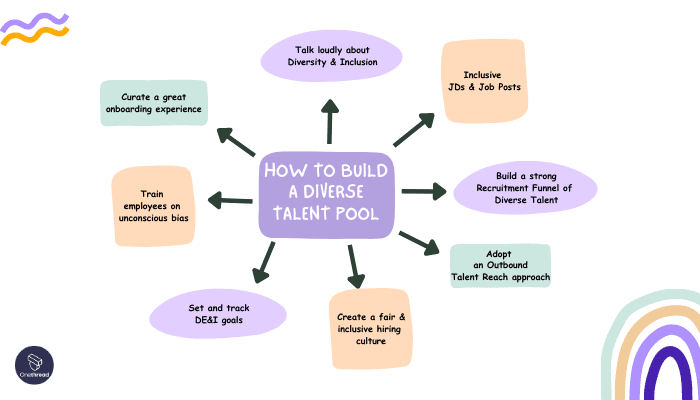
Bringing together experts from various disciplines enables organizations to tap into a pool of diverse skills and generate innovative ideas and solutions. Brainstorming sessions within cross-functional teams, comprising individuals with a wide range of expertise, foster out-of-the-box thinking and fresh perspectives.
This approach encourages unique problem-solving and supports the development of projects that require innovation.
Promotion of a Teamwork-Oriented Work Culture
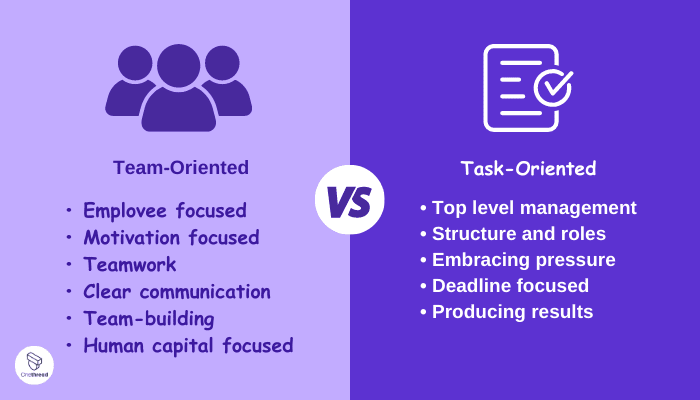
Cross-functional teams exemplify the importance of coordination and teamwork in achieving common goals. By showcasing the power of collaboration among individuals from different teams, these teams inspire other employees to value teamwork.
This promotes a work culture that emphasizes synergy and collective effort, leading to increased productivity and employee satisfaction.
Improved Team Communication
Cross-functional collaboration enhances communication skills among team members. Working with individuals from diverse backgrounds and personalities helps employees become effective communicators.
Clear and efficient communication acts as the foundation for successful collaboration, enabling better understanding, reduced conflicts, and a seamless flow of information within the team.
Accelerated Project Development and Timely Completion
One of the significant advantages of cross-functional teams is their ability to streamline project development and achieve timely completion. By bringing together experts from different departments, cross-functional teams eliminate the need for extensive collaboration with other departments.
They possess the necessary skills and experiences to independently track and resolve issues, ensuring self-sufficiency and efficient project delivery.
Enhancement of Management and Leadership Skills
Managing a cross-functional team composed of individuals with diverse skills and work styles enhances managerial and leadership skills. Handling such a team requires a comprehensive understanding of each member’s field.
Leaders in cross-functional teams must be able to comprehend and address the challenges faced by their team, making informed decisions to overcome them. This experience strengthens both managerial and leadership abilities.
Thrive in the Modern Workplace: Collaboration, Efficiency, and Strategic Thinking
Acquiring cross functional knowledge is crucial for thriving in the modern workplace. It paves the way for enhanced collaboration, breaking down barriers between departments and promoting seamless teamwork.
Additionally, it boosts efficiency by facilitating improved communication and coordination. Moreover, cross functional knowledge empowers individuals to think strategically, contributing to the organization’s overall success by considering the broader context of their actions.
Cross-functional collaboration unlocks a multitude of benefits for organizations, ranging from knowledge sharing and continuous learning to improved communication, streamlined project development, and enhanced management and leadership skills.
Challenges in Cross Functional Collaboration: Overcoming Barriers for Successful Teamwork
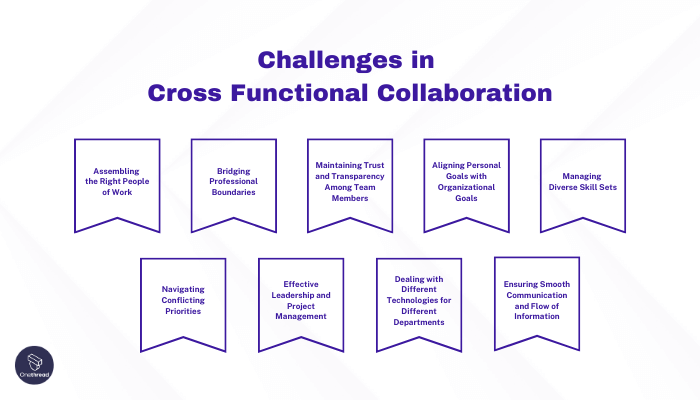
Addressing this challenge requires the development of new communication strategies and standardizing team communication tools. To achieve positive outcomes, it is crucial to enable instant and effective communication among employees and team members.
By recognizing and addressing these challenges, organizations can enhance their cross functional collaboration efforts, leading to improved teamwork and successful achievement of shared objectives.
1. Assembling the Right People
Finding the perfect blend of individuals from different departments who possess the required skills and experience is crucial for the success of cross functional collaboration. Careful selection ensures that team members are well-suited for the projects at hand.
Additionally, working in a dynamic environment with professionals from diverse backgrounds can be challenging. Therefore, it is essential to ensure that team members are adaptable and open to working under varying conditions.
2. Bridging Professional Boundaries:
Uniting professionals from different departments or functional areas requires breaking down silos and fostering effective communication channels. Overcoming interdepartmental barriers and establishing a shared understanding of project objectives can be complex but is crucial for successful collaboration.
3. Maintaining Trust and Transparency Among Team Members
When individuals from various departments come together, building trust and transparency becomes a significant obstacle. Without trust, productive collaboration becomes difficult, coordination suffers, and team members may become disengaged from their responsibilities.
Creating strategies to foster professional relationships among team members is vital in establishing trust within cross functional teams.
4. Aligning Personal Goals with Organizational Goals
Individual professional goals are often specialized and specific to their respective fields, such as marketing, software development, or customer service. When people from different departments collaborate, they may feel that the environment does not align with their personal goals.
It is crucial to communicate the benefits and growth opportunities that cross functional collaboration offers. Employees should be encouraged to align their personal goals with the organization’s objectives to ensure exceptional performance.
5. Managing Diverse Skill Sets:
Cross-functional teams consist of individuals with diverse skill sets and areas of expertise. Effectively managing and leveraging these varied talents to complement one another is essential for optimal project outcomes. Understanding team members’ strengths and assigning appropriate roles and responsibilities is vital.
6. Navigating Conflicting Priorities:
Each department or functional area may have its own set of priorities and objectives. Balancing these conflicting priorities within a cross-functional team requires skilled negotiation and alignment of goals. Clear communication channels and compromise are necessary to ensure everyone is working towards a common purpose.
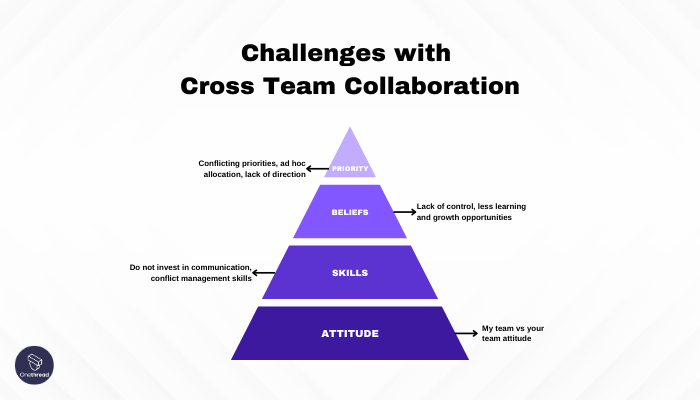
7. Effective Leadership and Project Management:
Managing a cross-functional team demands exceptional leadership skills. A capable leader must establish clear roles and responsibilities, facilitate communication, resolve conflicts, and ensure progress towards project milestones. Effective project management techniques and tools can help streamline processes and keep the team focused.
8. Dealing with Different Technologies for Different Departments
A significant challenge in cross functional collaboration lies in managing the diverse technologies used by various departments. Each department may rely on different tools and technologies to streamline their work processes.
When members of these departments join a cross functional team, their respective tools may hinder efficient collaboration. Overcoming this challenge involves carefully selecting the right set of tools that allow the team to centralize their work.
Minimizing the number of tools used and ensuring team members are willing to learn and adopt new technologies are crucial steps in fostering collaboration and efficient workflow.
9. Ensuring Smooth Communication and Flow of Information
Effective communication is essential for the success of cross functional collaboration. As different departments operate independently, they develop unique communication strategies and methods. However, when these departments merge to form a single unit, communication barriers arise.
Strategies for Enhancing Cross-Functional Collaboration in Your Organization
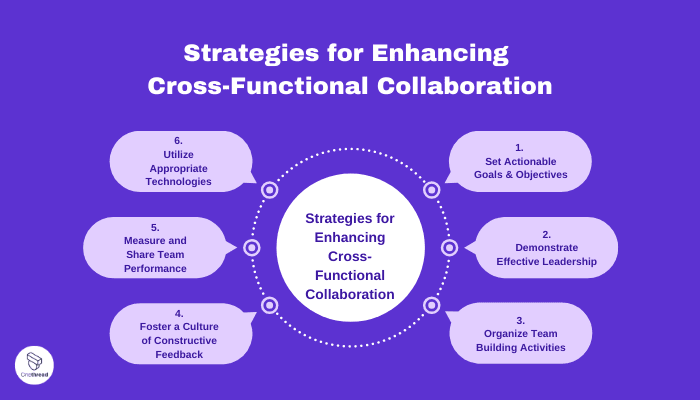
By implementing these strategies, your organization can create an environment conducive to effective cross-functional collaboration, promoting teamwork, innovation, and achieving shared goals across departments.
#1 Set Actionable Goals & Objectives
To ensure successful cross-functional collaboration, it is crucial to establish clear and actionable goals and objectives. Each team member brings their unique perspectives and motivations, which can lead to conflicts and deviations if not properly aligned.
By defining a shared set of goals, you create a middle-ground for coordination and cooperation among team members, enabling them to work together towards a common purpose.
#2 Demonstrate Effective Leadership
Leadership plays a vital role in determining the success of cross-functional collaboration. A competent leader adopts a proactive approach to address challenges and develops systematic plans.
It is essential for leaders to encourage their cross-functional teams to take ownership of their actions. By leading by example and providing guidance and support, leaders inspire their teams to give their best effort in accomplishing tasks and projects.
#3 Organize Team Building Activities
Cross-functional collaboration often requires individuals from different backgrounds to work together. To foster a sense of unity and synergy among team members, organizing team building activities is key.
These activities provide an opportunity for individuals to get to know and connect with each other in a natural and informal setting, facilitating stronger relationships and effective collaboration.
#4 Foster a Culture of Constructive Feedback
Feedback plays a significant role when working in a group, but it can be challenging within a cross-functional team due to diverse perspectives. As a leader, it is important to possess a good understanding of various subjects to provide constructive feedback.
Encouraging constructive feedback allows team members to identify areas for improvement and enhance their performance. When individuals feel that they are growing and developing as part of a cross-functional team, they become more engaged and motivated.
#5 Measure and Share Team Performance
The ultimate aim of cross-functional collaboration is to develop high-performance teams capable of delivering exceptional results. To ensure team members are aware of their performance and meeting organizational expectations, it is essential to measure team performance against Key Performance Indicators (KPIs).
Sharing the results with the team fosters transparency and accountability. Additionally, celebrating and recognizing team achievements helps to boost morale and motivation.
#6 Utilize Appropriate Technologies
To unlock the full potential of cross functional partnerships/collaboration, leveraging the right technologies is imperative. Equipping cross-functional teams with tools and technologies that enhance productivity is essential since these teams often work independently.
For example, using project management software allows teams to efficiently manage projects, tasks, and clients from a centralized platform. Similarly, employing a team communication tool facilitates seamless conversations and connectivity among team members.
Onethread: Empowering Cross-Team Collaboration with Powerful Features
Onethread is an all-in-one project management and team collaboration software that enables seamless collaboration across functional teams. It offers a comprehensive set of tools to enhance project control and facilitate effective team communication, making it a trusted choice for businesses seeking to incorporate cross organizational collaboration.
Best Features in Onethread
Task and Workflow Management:
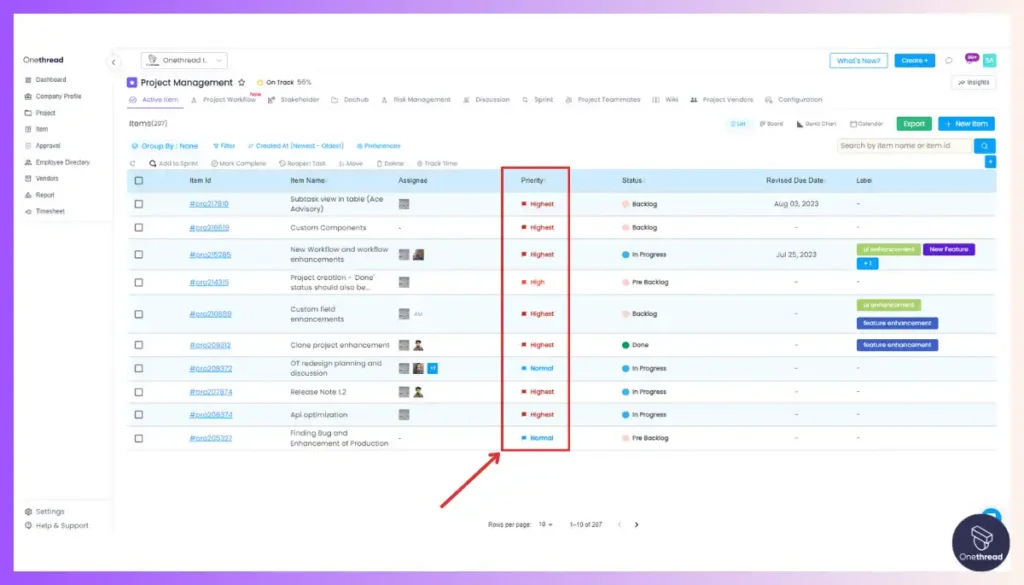
Onethread’s Kanban boards provide a streamlined workflow and organized task management. Each project has a dedicated board where tasks can be defined, assigned to team members, and tracked in real-time. Task cards offer detailed information, including attachments, comments, and subtasks, ensuring clarity and transparency.
Project Scheduling and Progress Tracking:
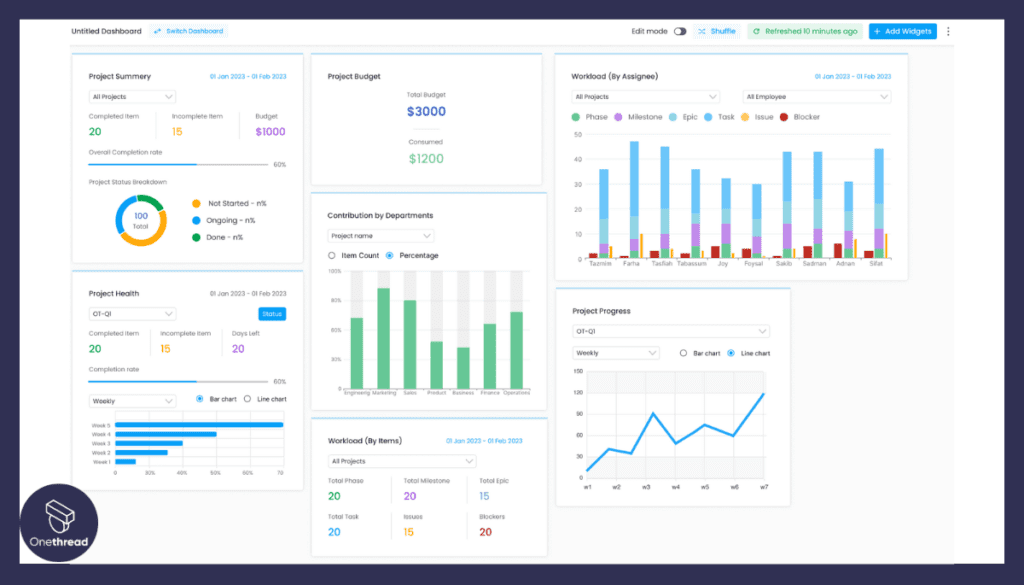
Onethread’s Gantt charts empower users to define task schedules, set dependencies, and prioritize tasks. The timeline view visualizes tasks, allowing easy modification through drag-and-drop. Critical paths can be identified, enabling better management of project timelines.
Instant Team Communication:
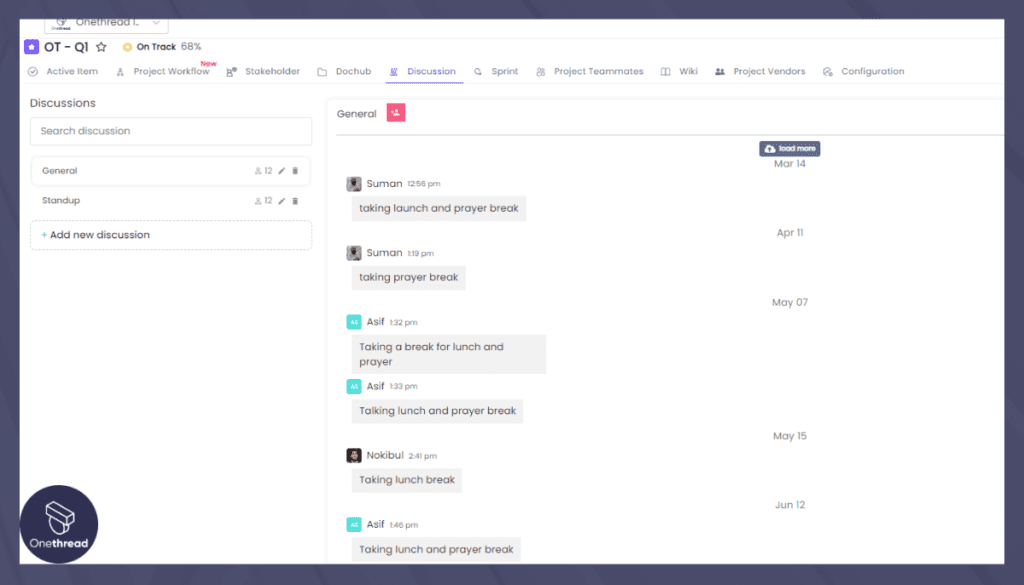
The built-in chat tool facilitates quick text-based conversations, enabling one-on-one or group discussions among team members. Users can share various file types, such as documents, images, and videos, within the chat interface, promoting efficient collaboration.
Collaboration on Files:
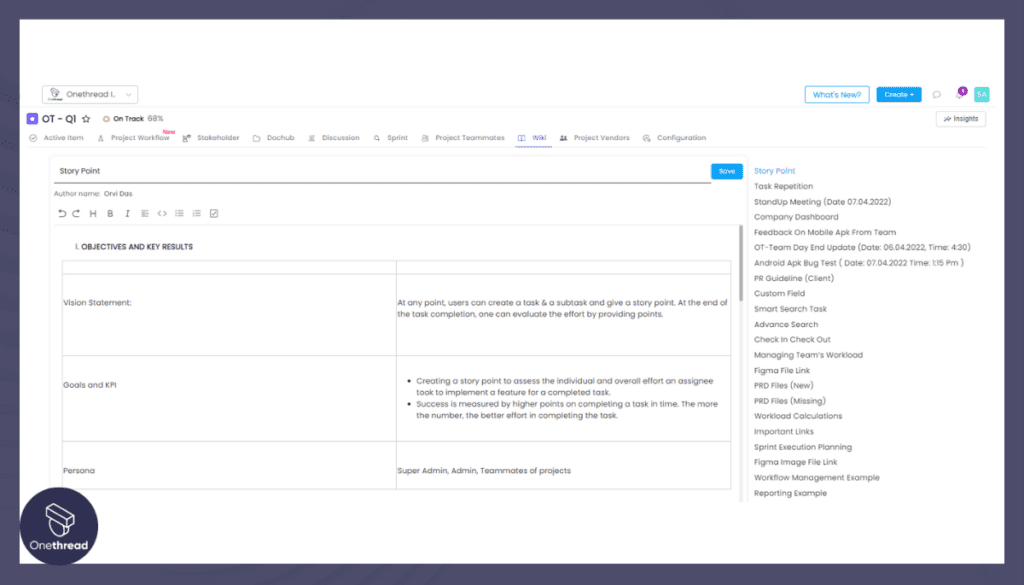
Onethread’s online proofing feature expedites the file review and approval process. Team members can share designs and documents, provide feedback as comments, and make approvals with a single click. File versioning allows for easy comparison and review of changes.
Assigning Team Roles and Responsibilities:
Onethread provides granular control over project access by allowing users to create and assign custom roles to team members. Access levels can be determined for each role, ensuring confidentiality and restricting access to specific project sections.
Evaluating Performance of Projects and Resources:
Onethread’s advanced reporting capabilities enable monitoring and evaluation of project performance. Custom project reports can be created, highlighting specific data parameters. Resource reports assist in assessing individual team members’ performance.
Celebrating Achievements and Milestones:
Onethread features a dedicated announcement section to recognize team achievements, deliver birthday greetings, and make formal announcements. Users can select the recipients of announcements and set their visibility duration.
Affordability (Pricing):

For detailed pricing information, please visit Onethread’s pricing page.
Onethread’s extensive range of features empowers cross-functional teams to collaborate effectively, streamline workflows, and achieve project success. With its comprehensive toolset and user-friendly interface, Onethread is a reliable solution for organizations seeking to enhance cross-team collaboration.
Final Word
Cross-functional collaboration presents a valuable opportunity to enhance team performance by leveraging the diverse expertise and perspectives of individuals from different professional backgrounds. By forming specialized teams composed of individuals from various departments, organizations can tackle complex projects while prioritizing innovation and efficiency.
However, it is crucial to be aware of the challenges associated with cross-functional collaboration in order to effectively prepare for them. By implementing the strategies outlined in this article, organizations can establish and nurture successful cross organizational collaboration, transforming their workplaces into productive, innovative, and harmonious environments.
Embracing cross-functional knowledge can lead to improved outcomes, increased employee satisfaction, and ultimately, a competitive advantage in today’s dynamic business landscape.
Unlock the power of cross-functional knowledge with Onethread and revolutionize your team’s collaboration. Experience seamless integration and enhance productivity. Try Onethread today!
Frequently Asked Questions
How Does Cross Functional Knowledge Contribute To Employee Job Satisfaction?
Understanding the different aspects of your job and collaborating with colleagues from various departments can enhance your job satisfaction. It allows you to gain new skills, learn from others, and feel a sense of accomplishment in contributing to the company’s overall success.
What Are Some Strategies For Fostering Effective Communication Within A Cross Functional Team?
To foster effective communication within a cross functional team, you can encourage open and transparent communication, establish regular team meetings, use collaboration tools, promote active listening, provide clear expectations, and encourage feedback and constructive criticism.
Are There Any Potential Downsides Or Limitations To Cross Functional Knowledge In The Modern Workplace?
There can be potential downsides or limitations to cross functional knowledge in the modern workplace. It may lead to information overload, lack of specialization, and difficulty in decision making due to conflicting perspectives and priorities.
How Can An Individual Actively Develop Cross Functional Skills Outside Of Their Current Job Role?
To actively develop cross functional skills outside of your current job role, you can seek opportunities to work on projects or tasks in different departments, take on additional responsibilities, and collaborate with colleagues from diverse backgrounds.
Can You Provide Any Real-Life Examples Of Companies That Have Successfully Implemented Cross Functional Collaboration And The Impact It Had On Their Organization’s Success?
Sure! Many companies, like Google and Apple, have embraced cross functional collaboration. This has led to increased innovation, improved decision-making, and enhanced problem-solving capabilities, ultimately driving their success in the market.
